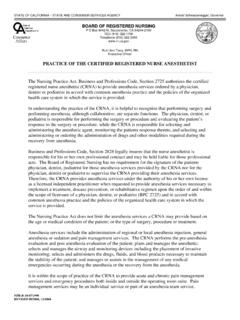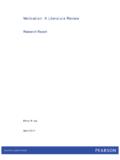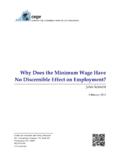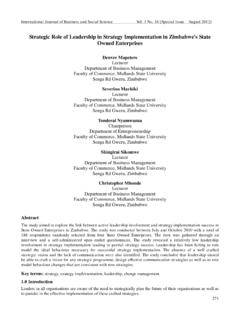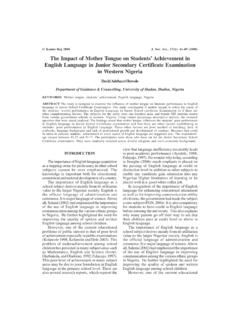Transcription of Consensus Guidelines for Managing Postoperative …
1 SPECIALARTICLEC onsensus Guidelines for Managing Postoperative Nauseaand VomitingTong J. Gan,MD*, Tricia Meyer,MS,FASHP , Christian C. Apfel,MD , Frances Chung,FRCPC ,Peter J. Davis,MD , Steve Eubanks,MD , Anthony Kovac,MD#, Beverly K. Philip,MD**,Daniel I. Sessler,MD , James Temo,CRNA,MSN,MBA , Martin R. Trame`r,MD,DPhil , andMehernoor Watcha,MD Departments of *Anesthesiology and Surgery, Duke University Medical Center, Durham, North Carolina; Departmentsof Pharmacy and Anesthesiology, Scott and White Memorial Hospital, Texas A&M University System HSC College ofMedicine, Temple, Texas; Outcomes Research Group and Department of Anesthesiology, University of Wuerzburg,Wuerzburg, Germany; Department of Anesthesia, University of Toronto, Toronto, Canada; Departments ofAnesthesiology and Pediatrics, University of Pittsburgh School of Medicine, Pittsburgh, Pennsylvania; #Department ofAnesthesiology, University of Kansas Medical Center, Kansas City, Kansas; **Department of Anaesthesia, HarvardMedical School, Boston, Massachusetts.
2 Outcomes Research Institute and Departments of Anesthesiology andPharmacology, University of Louisville, Louisville, Kentucky; Duke University Nurse Anesthetist Program, Durham,North Carolina; Division of Anaesthesiology, Geneva University Hospital, Geneva, Switzerland; and Department ofAnesthesia, Children s Hospital of Philadelphia, Philadelphia, PennsylvaniaPostoperative nausea and vomiting (PONV) con-tinues to be a common complication of is a limiting factor in the early discharge ofambulatory surgery patients and is a leading cause ofunanticipated hospital admission (1,2). PONV canlead to increased recovery room time, expanded nurs-ing care, and potential hospital admission all factorsthat may increase total health care costs.
3 Equally im-portant are the high levels of patient discomfort anddissatisfaction associated with PONV. Patients reportthat avoidance of PONV is of greater concern thanavoidance of Postoperative pain (3) and are willing tospend up to US$100 out of pocket for an effectiveantiemetic (4), yet more than a quarter of patientscontinue to experience PONV within 24 h of surgery(5,6). Among high-risk patients, the incidence ofPONV can be as frequent as 70% to 80% (7). Publishedevidence suggests that universal PONV prophylaxis isnot cost-effective. Although some advocate prophy-lactic antiemetic therapy for high-risk patients andrescue antiemetic treatment for episodes of PONV, theoptimal approach to PONV management remains un-clear to many clinicians.
4 Guidelines for preventionand treatment of PONV based on data from system-atic reviews of randomized trials have been published(8,9). However, these Guidelines did not consider ev-idence from sources other than systematic from single studies or data from logisticregression (aiming to identify risk factors for PONV)were not included. These Guidelines also need to beupdated with new evidence on the control of of Expert GuidelinesA multidisciplinary panel of experts convened to re-view the medical literature on PONV (up to February2002) and to produce Guidelines for its managementthat were valid, reliable, clinically applicable, flexible,and clear. In establishing the Guidelines , the panelbased their recommendations on available evidenceSupported by an unrestricted educational grant from Aventis, company had no input into the content of this following authors have conflicts of interest or potential con-flicts of interest.
5 T. J. Gan speaker s bureau: Pharmacia, Abbott,GlaxoSmithKline, Merck; research support: Pharmacia, Abbott, Gl-axoSmithKline, Aspect, and Roche; consultant: Pharmacia, Abbott,Roche, and GlaxoSmithKline. T. Meyer speaker: Aventis, Abbott,Baxter, and Novartis Consumer Health. C. C. Apfel honoraria andresearch grants from AstraZeneca, GlaxoSmithKline, and J. Davis consultant: Abbott, Baxter, and GlaxoSmithKline; hon-orarium, Abbott, Baxter, and GlaxoSmithKline; research support:Abbott, Baxter, and GlaxoSmithKline. A. Kovac research grantsupport: GlaxoWellcome, Roche Pharmaceuticals, and HoechstMarion Roussel (now Aventis Pharmaceuticals); speaker s bureau:GlaxoWellcome, Roche Pharmaceuticals, and Abbott K.
6 Philip speaking honoraria and research support: Abbott,Baxter, GlaxoSmithKline, Novartis, and Roche. M. R. Trame`r lecture fees: MSD and Pharmacia. M. Watcha consultant: BaxterPharmaceutical Products, Roche Pharmaceuticals; research support:Baxter, Abbott Laboratories, AstraZeneca, and Aspect; for publication March 3, correspondence and reprint requests to Tong J. Gan, De-partment of Anesthesiology, Duke University Medical Center, TrentDrive, Durham, NC 27710. Address e-mail to 2003 by the International Anesthesia Research Society62 Anesth Analg 2003;97:62 710003-2999/03regarding the prevention or minimization of PONV with prophylactic and/or rescue therapy. Members ofthe panel were assigned specific topics to review be-fore the meeting.
7 Evidence was then presented anddiscussed at the meeting before a Consensus wasreached. When full agreement could not be obtained,the majority view was presented, and the lack of fullagreement was of GuidelinesThe panel defined the following goals for the Guidelines :1) identify the primary risk factors for PONV in adultsand children, 2) reduce the baseline risks for PONV, 3)identify the optimal approach to PONV prevention andtherapy in various patient populations, 4) determine theoptimal choice and timing of antiemetic administration,and 5) identify the most effective antiemetic mono-therapy and combination therapy of EvidenceThe panel consulted the medical literature for level ofevidence rating scales that were pertinent and widelyused and then adapted them to the body of scientificliterature relating to PONV (10,11).
8 In the absence ofpublished data, recommendations were made on thebasis of expert opinion. The scales used in rating theguidelines are shown in Table aim of the evidence rating scale was to presentinformation on both the design and the source of thedata (I to V) independent of the validity of those quality of the data was judged by the panel, whichdetermined whether the recommendation was good,fair, or insufficient. For instance, a logistic regressionanalysis that aims to identify risk factors for PONV would be in Level IV, because such trials are notrandomized. However, information emerging fromthat study may be judged as A by the GuidelinesThe panel agreed that recommendations for PONV prophylaxis and treatment must consider the follow-ing factors: the patient s level of PONV risk; potentialmorbidity associated with PONV, including suturedehiscence (12), esophageal rupture (13,14), hema-toma formation, and aspiration pneumonitis (15); po-tential adverse events associated with the various an-tiemetics, in particular the recent Food and DrugAdministration (FDA) warning about QT prolonga-tion and fatal arrhythmias associated with droperidol;efficacy of antiemetics; costs of antiemetic therapy.
9 And increased health care costs associated with panel agreed that not all patients should receivePONV prophylaxis. In general, patients at small riskfor PONV are unlikely to benefit from prophylaxisand would be put at unnecessary risk from the poten-tial side effects of antiemetics. Thus, prophylaxisshould be reserved for those patients at moderate tohigh risk for PONV. In developing these Guidelines ,the panel deliberately chose, for several reasons, not toquantify the percentage of patients who would be inthe low-, moderate-, and high-risk categories. The sen-sitivity and specificity of the various risk scoring sys-tems are not 100% (only approximately 70%) andhence have a degree of uncertainty (16 18).
10 Even ifhealth care providers knew with confidence the trueunderlying risk, their and the patient s perception ofthis risk and, thus, the need for prophylaxis, wouldnot be universally accepted. The decision was made,instead, to allow the health care professionals who usethe Guidelines to determine the level of risk accordingto their own local and institutional norms. For in-stance, although a 20% incidence of PONV may con-stitute a small risk in some institutions, it may beconsidered a moderate risk in others because of insti-tutional variations in rates of ambulatory surgery,types of surgery, and patient populations. In addition,the decision to give antiemetic prophylaxis should bereached by both the care provider and the patient onthe basis of the best available the Guidelines , antiemetic efficacywas expressed as number needed to treat (NNT)whenever this information was available from theliterature.
